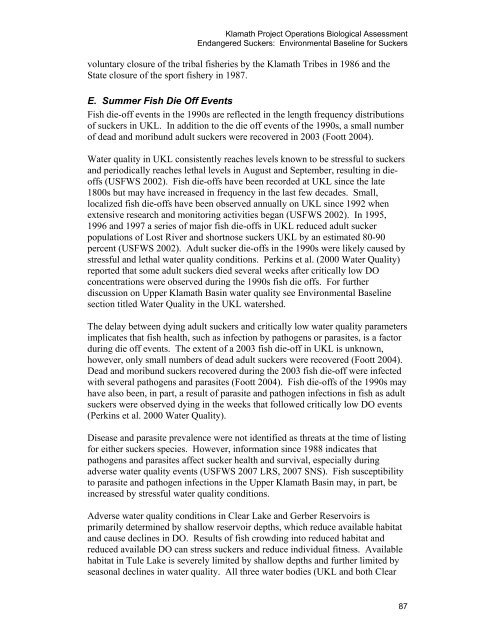Our new Biological Assessment is out - Klamath Basin Crisis
Our new Biological Assessment is out - Klamath Basin Crisis
Our new Biological Assessment is out - Klamath Basin Crisis
Create successful ePaper yourself
Turn your PDF publications into a flip-book with our unique Google optimized e-Paper software.
<strong>Klamath</strong> Project Operations <strong>Biological</strong> <strong>Assessment</strong><br />
Endangered Suckers: Environmental Baseline for Suckers<br />
voluntary closure of the tribal f<strong>is</strong>heries by the <strong>Klamath</strong> Tribes in 1986 and the<br />
State closure of the sport f<strong>is</strong>hery in 1987.<br />
E. Summer F<strong>is</strong>h Die Off Events<br />
F<strong>is</strong>h die-off events in the 1990s are reflected in the length frequency d<strong>is</strong>tributions<br />
of suckers in UKL. In addition to the die off events of the 1990s, a small number<br />
of dead and moribund adult suckers were recovered in 2003 (Foott 2004).<br />
Water quality in UKL cons<strong>is</strong>tently reaches levels known to be stressful to suckers<br />
and periodically reaches lethal levels in August and September, resulting in dieoffs<br />
(USFWS 2002). F<strong>is</strong>h die-offs have been recorded at UKL since the late<br />
1800s but may have increased in frequency in the last few decades. Small,<br />
localized f<strong>is</strong>h die-offs have been observed annually on UKL since 1992 when<br />
extensive research and monitoring activities began (USFWS 2002). In 1995,<br />
1996 and 1997 a series of major f<strong>is</strong>h die-offs in UKL reduced adult sucker<br />
populations of Lost River and shortnose suckers UKL by an estimated 80-90<br />
percent (USFWS 2002). Adult sucker die-offs in the 1990s were likely caused by<br />
stressful and lethal water quality conditions. Perkins et al. (2000 Water Quality)<br />
reported that some adult suckers died several weeks after critically low DO<br />
concentrations were observed during the 1990s f<strong>is</strong>h die offs. For further<br />
d<strong>is</strong>cussion on Upper <strong>Klamath</strong> <strong>Basin</strong> water quality see Environmental Baseline<br />
section titled Water Quality in the UKL watershed.<br />
The delay between dying adult suckers and critically low water quality parameters<br />
implicates that f<strong>is</strong>h health, such as infection by pathogens or parasites, <strong>is</strong> a factor<br />
during die off events. The extent of a 2003 f<strong>is</strong>h die-off in UKL <strong>is</strong> unknown,<br />
however, only small numbers of dead adult suckers were recovered (Foott 2004).<br />
Dead and moribund suckers recovered during the 2003 f<strong>is</strong>h die-off were infected<br />
with several pathogens and parasites (Foott 2004). F<strong>is</strong>h die-offs of the 1990s may<br />
have also been, in part, a result of parasite and pathogen infections in f<strong>is</strong>h as adult<br />
suckers were observed dying in the weeks that followed critically low DO events<br />
(Perkins et al. 2000 Water Quality).<br />
D<strong>is</strong>ease and parasite prevalence were not identified as threats at the time of l<strong>is</strong>ting<br />
for either suckers species. However, information since 1988 indicates that<br />
pathogens and parasites affect sucker health and survival, especially during<br />
adverse water quality events (USFWS 2007 LRS, 2007 SNS). F<strong>is</strong>h susceptibility<br />
to parasite and pathogen infections in the Upper <strong>Klamath</strong> <strong>Basin</strong> may, in part, be<br />
increased by stressful water quality conditions.<br />
Adverse water quality conditions in Clear Lake and Gerber Reservoirs <strong>is</strong><br />
primarily determined by shallow reservoir depths, which reduce available habitat<br />
and cause declines in DO. Results of f<strong>is</strong>h crowding into reduced habitat and<br />
reduced available DO can stress suckers and reduce individual fitness. Available<br />
habitat in Tule Lake <strong>is</strong> severely limited by shallow depths and further limited by<br />
seasonal declines in water quality. All three water bodies (UKL and both Clear<br />
87










